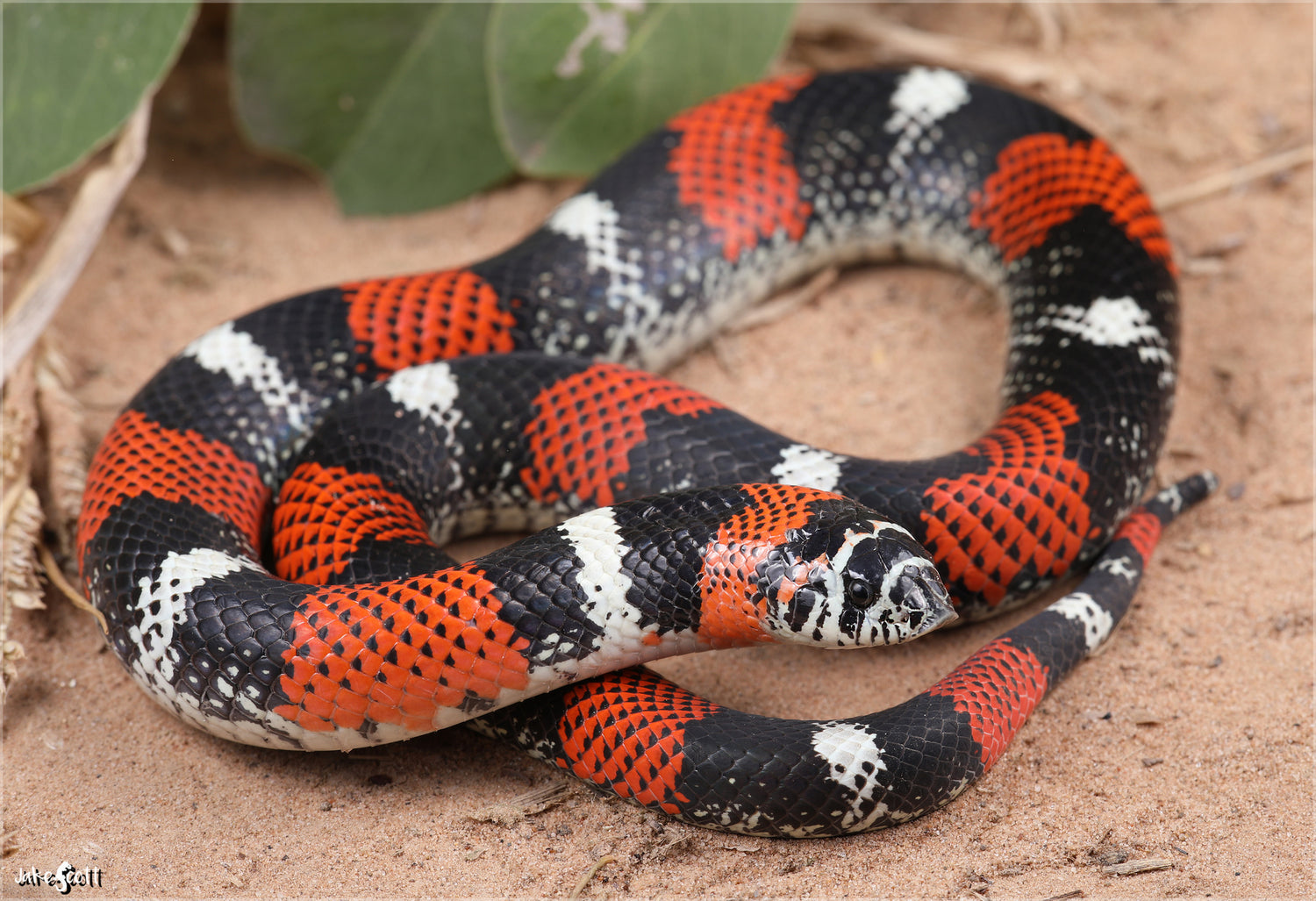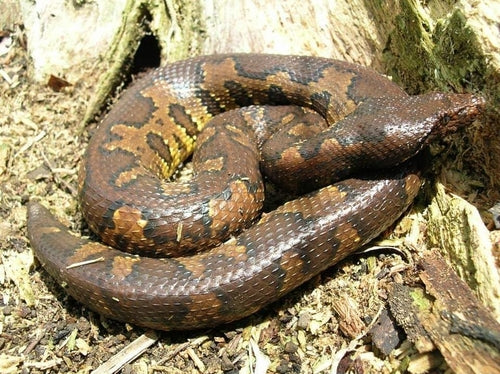Tricolor hognose snakes (Xenodon pulcher) are small, fossorial snakes native to the Chaco region of South America, which includes parts of Bolivia, Paraguay, Argentina, and Brazil. They prefer more arid habitats with sandy soil, such as grassland, savannah, shrubland, and sometimes woodland.
Tricolor hognose snakes generally grow up to 2’ long, and they do not demonstrate the extreme sexual dimorphism that is seen in North American hognoses. They have a blunt triangular head, rounded “cheeks,” an upturned snout, and smooth scales. Base color is striking red, interrupted with broad black bands that enclose a stripe of white. The head is black with thin white striping, and the belly is white.
Tricolor hognose snakes are fairly easy to care for when acquired captive-bred, and can make good pets for someone interested in a smaller snake. The most difficult thing about keeping this species is accommodating their unique diet.
How much space do tricolor hognose snakes need?
The minimum enclosure size for tricolor hognose snakes is 30”L x 12”W x 12”H, but larger is preferred, and some argue that 36”L x 18”W x 16”H is a more appropriate minimum. The enclosure should be front-opening for secure access, but make sure there is a substrate guard at least 4” tall.
Cohabitation (keeping multiple tricolor hognose snakes in one enclosure) is not recommended.
Do tricolor hognose snakes need UVB?
They can survive without it, but it’s still best practice to provide UVB lighting for optimal health and wellbeing. Hognose snakes are diurnal after all, so it’s likely that they are routinely exposed to sunlight in the wild. UVB gives snakes all of the vitamin D that their bodies need, stimulates better appetite and activity, and generally allows them to be healthier than they would be without.
Here are the best UVB bulbs for tricolor hognose snakes:
- Arcadia ShadeDweller kit — 6-8” (mesh), 8-10” (no mesh)
- Arcadia T5 HO Forest 6% — 9-11” (mesh), 12”-14” (no mesh)
- Zoo Med T5 HO Reptisun 5.0 — 9-11” (mesh), 12”-14” (no mesh)
The UVB bulb should be housed in a reflective fixture (Arcadia or Vivarium Electronics) and placed on the same side as the heat lamp, half the length of the enclosure. Place the basking surface so the snake’s back will be at an appropriate distance away from the UVB lamp, depending on what bulb you’re using.
UVB is blocked by glass and plastic, so you can’t give your snake UVB by placing its terrarium in front of an open window. Replace the bulb every 12 months to maintain optimal performance.
Lights should be on for 14 hours/day during summer and 10 hours/day during winter. This replicates seasonal light cycles, encouraging healthier hormonal rhythms and possibly better long-term health.
What basking temperatures do tricolor hognose snakes need?
Like other reptiles, tricolor hognose snakes are ectotherms, which means that they need a temperature gradient in their enclosure to help them regulate their metabolism and stay healthy.
Tricolor hognose snakes should have a basking surface temperature between 90-95°F with a cool side temperature of 72-82°F. Measure your temperature gradient with an infrared thermometer.
Provide heat for your tricolor hognose by imitating the sun with a halogen heat bulb placed on one side of the enclosure, positioned over a large, flat stone placed on top of the substrate. Do not use ceramic heat emitters (CHEs), heat mats, red bulbs, or blue bulbs, as these are not as effective. If the bulbs are too cool, you need a higher wattage. If they’re slightly too warm, use a lamp dimmer.
Heating should be turned off at night.
What humidity levels do tricolor hognose snakes need?
Tricolor hognose snakes prefer environments with low to moderate humidity. Average air humidity in your snake’s enclosure should be between 30-50% on average, higher at night and lower during the day. This should be measured by a digital probe hygrometer placed in the middle of the enclosure.
Although the enclosure can be kept fairly dry, it’s a good idea to offer a humid hide lined with moistened substrate for the snake to use as desired. Alternatively, you can wet down the substrate on the cool side of the enclosure so it is slightly damp. This is especially helpful during shedding.
What substrate is good for tricolor hognose snakes?
Substrate (also known as bedding) is essential to hognose snakes because they’re a fossorial (burrowing) species. Having plenty of loose substrate to dig in is essential to their mental wellbeing. We recommend the following substrates as options for tricolor hognose snakes:
- Zoo Med Aspen Snake Bedding
- Exo Terra Snake Bedding
- Zoo Med Eco Earth
- Exo Terra Plantation Soil
- Zoo Med Reptisoil
Substrate should be at least 3” deep and completely replaced every 3-4 months. Remove poop and urates daily, along with contaminated substrate.
What décor can you use in a tricolor hognose snake terrarium?
Hognose snakes may be fossorial, but that doesn’t mean they don’t spend time above the substrate. It’s terribly boring for a snake to be stuck in an enclosure with nothing in it except substrate and a water bowl.
Here are some ways to spice up your snake’s enclosure to make it both more attractive and more functional:
- leaf litter
- hides/caves
- sturdy branches
- cork flats/tubes
- artificial plants
- live, drought-tolerant plants
It’s also good practice to cover three sides of the enclosure with opaque material to help your snake feel more secure in its environment.
What do tricolor hognose snakes eat?
Like other snakes, tricolor hognose snakes are carnivores, which means that they need to eat whole animal prey in order to get the nutrition that they need. Here is a basic feeding schedule:
- Babies and juveniles — every 5-7 days
- Adults — every 10-14 days
Prey items should be roughly the same width as the snake’s widest point. Although live prey can be used, it’s safest and most humane to use frozen instead. Prey should be fully thawed before offering.
Tricolor hognose snakes eat primarily amphibians, lizards, and reptile eggs in the wild, so it’s best to replicate this diet in captivity. Offering a high-calorie, rodent-heavy diet may lead to fatty liver disease and a shortened lifespan. Try offering frog and anole Reptilinks, button quail chicks, and quail eggs, with pinky mice only as an occasional treat.
Remember, the key to great nutrition is variety!
Supplements
Tricolor hognose snakes can survive without vitamin or mineral supplements, but occasionally using them can help prevent nutritional deficiencies and optimize your snake’s health. We recommend Repashy Calcium Plus LoD.
Water
Your snake should have access to clean, fresh water at all times. Provide a heavy water bowl large enough for the snake to soak its entire body as desired. Keep the water clean and scrub the bowl with a reptile-safe disinfectant weekly.
Do tricolor hognose snakes like to be handled?
Few reptiles actually “like” to be held, but tricolor hognose snakes generally tame down well enough. Be gentle, and pick up the snake from below rather than from above. Support as much of its body as possible, but don’t try to restrain it; let it explore. More frequent handling is likely to result in a more tame snake, although handling should not take place more than once a day. NEVER pick up a snake by its tail!
Because hognose snakes are technically (rear-fanged) venomous, special care should be taken when handling them. If they bite, do not let them chew on you, as that injects more venom, increasing the likelihood of effects. If you are worried about getting bitten, wear thick leather gloves during handling.
*This care sheet contains only very basic information. Although it’s a good introduction, please do further research with high-quality sources to obtain additional information on caring for this species.
“Photo 122112562” by jakescott is licensed under CC BY-NC 4.0




Leave a comment
This site is protected by hCaptcha and the hCaptcha Privacy Policy and Terms of Service apply.